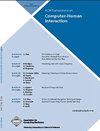RadarHand: a Wrist-Worn Radar for On-Skin Touch-based Proprioceptive Gestures
IF 4.8
2区 计算机科学
Q1 COMPUTER SCIENCE, CYBERNETICS
引用次数: 0
Abstract
We introduce RadarHand, a wrist-worn wearable with millimetre wave radar that detects on-skin touch-based proprioceptive hand gestures. Radars are robust, private, small, penetrate materials, and require low computation costs. We first evaluated the proprioceptive and tactile perception nature of the back of the hand and found that tapping on the thumb is the least proprioceptive error of all the finger joints, followed by the index finger, middle finger, ring finger, and pinky finger in the eyes-free and high cognitive load situation. Next, we trained deep-learning models for gesture classification. We introduce two types of gestures based on the locations of the back of the hand: generic gestures and discrete gestures. Discrete gestures are gestures that start at specific locations and end at specific locations at the back of the hand, in contrast to generic gestures, which can start anywhere and end anywhere on the back of the hand. Out of 27 gesture group possibilities, we achieved 92% accuracy for a set of seven gestures and 93% accuracy for the set of eight discrete gestures. Finally, we evaluated RadarHand’s performance in real-time under two interaction modes: Active interaction and Reactive interaction. Active interaction is where the user initiates input to achieve the desired output, and reactive interaction is where the device initiates interaction and requires the user to react. We obtained an accuracy of 87% and 74% for active generic and discrete gestures, respectively, as well as 91% and 81.7% for reactive generic and discrete gestures, respectively. We discuss the implications of RadarHand for gesture recognition and directions for future works.RadarHand:一种腕式雷达,用于基于皮肤触摸的本体感觉手势
我们介绍RadarHand,这是一款带毫米波雷达的腕戴式可穿戴设备,可以检测基于皮肤触摸的本体感觉手势。雷达是强大的,私有的,小的,穿透材料的,并且需要低的计算成本。我们首先评估了手背的本体感觉和触觉感知性质,发现在无眼和高认知负荷情况下,敲击拇指是所有手指关节中本体感觉误差最小的,其次是食指、中指、无名指和小指。接下来,我们训练了用于手势分类的深度学习模型。我们根据手背的位置介绍两种类型的手势:通用手势和离散手势。离散手势是从手背的特定位置开始并在特定位置结束的手势,与一般手势相反,一般手势可以从手背的任何位置开始和结束。在27个手势组的可能性中,我们对一组7个手势的准确率达到92%,对一组8个离散手势的准确率达到93%。最后,我们对RadarHand在主动交互和被动交互两种交互模式下的实时性能进行了评估。主动交互是用户发起输入以实现所需输出的地方,而被动交互是设备发起交互并要求用户做出反应的地方。我们对主动通用手势和离散手势的准确率分别为87%和74%,对反应性通用手势和离散手势的准确率分别为91%和81.7%。我们讨论了RadarHand对手势识别的意义和未来工作的方向。
本文章由计算机程序翻译,如有差异,请以英文原文为准。
求助全文
约1分钟内获得全文
求助全文
来源期刊

ACM Transactions on Computer-Human Interaction
工程技术-计算机:控制论
CiteScore
8.50
自引率
5.40%
发文量
94
审稿时长
>12 weeks
期刊介绍:
This ACM Transaction seeks to be the premier archival journal in the multidisciplinary field of human-computer interaction. Since its first issue in March 1994, it has presented work of the highest scientific quality that contributes to the practice in the present and future. The primary emphasis is on results of broad application, but the journal considers original work focused on specific domains, on special requirements, on ethical issues -- the full range of design, development, and use of interactive systems.
 求助内容:
求助内容: 应助结果提醒方式:
应助结果提醒方式:


